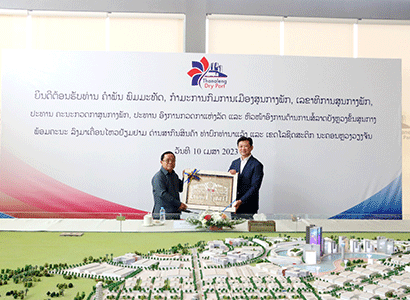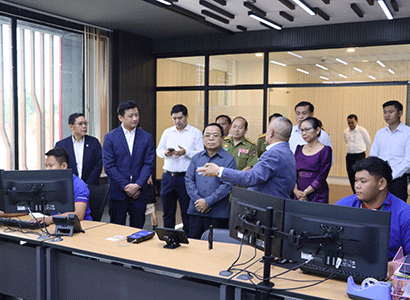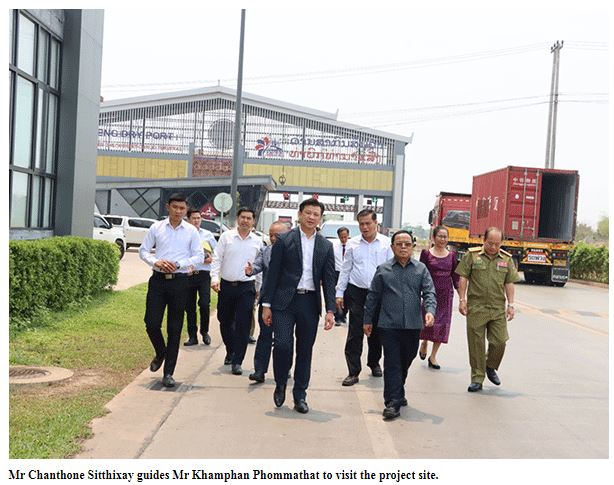Thanaleng Dry Port ‘a key driver to support Laos becoming a new global supply chain’
Top state inspector Khamphan Phommathat on Monday visited the Thanaleng Dry Port, Laos’ first ever integrated logistics centre. It is part of the Lao Logistics Link project, which is projected to grow Laos’ GDP by 20 percent.
The Thanaleng Dry Port, Laos’ first ever integrated logistics centre, is driving the country to become a new regional and global supply chain, its developer has told the top state inspector.
Connecting to the Laos-China railway – part of the global transport infrastructure, the Belt and Road Initiative – the dry port facilitates cargo shipment by rail between Southeast Asia and Europe, taking a much shorter time.
“Goods shipped from Southeast Asia to European markets take about 15 days by rail, much shorter than the 45 days it takes by sea,” said Chanthone Sitthixay, Chairman of the Vientiane Logistics Park Co., Ltd., the developer of the dry port.
He gave a presentation on the multimodal transport project to the politburo member and President of the State Inspection Authority, Khamphan Phommathat, who visited the US$727-million dry port and the Vientiane Logistics Park in Vientiane on Monday.
“Vientiane will become an important distributor of European products for the Southeast Asian region,” the Chairman said, given the advantage of reduced transport times.
Containing extensions of the Laos-China and Laos-Thailand rail tracks, the dry port has become an important trade gateway between Southeast Asia and China – the world’s second largest economy with 1.4 billion consumers.
Open for service since December 2021, the dry port has seen increasing traffic volume.
Last year, more than 40,000 containers passed through the dry port. The developer expects that container volume will rise by more than 100 percent or even reach 200 percent to 100,000 and 120,000 containers respectively this year following the lifting of Covid-19 restrictions that have sparked a surge in trade.
To unlock trade and investment potential, the Lao developer in November last year broke ground on the construction of a logistics park where investors are welcome to do business. The logistics complex comprises a plant and animal quarantine facility, a tank farm, export processing centre, logistics park, free trade zone, and technology and halal hubs.
 |
 |
| Mr Khamphan Phommathat (fifth left), Mr Chanthone Sitthixay (sixth left) and officials from both sides gather for group photo. | Mr Chanthone Sitthixay (right) presents a gift to Mr Khamphan Phommathat. |
Built in partnership with China at a cost of US$20 million, construction of the plant and animal quarantine centre is expected to be complete by the end of this year. Once it is operational, the centre will provide cost-effective services for the import, export and transit of farm produce, notably between China and Thailand via Laos.
Plant and animal products that have quarantine certificates issued by the new centre could reach Chinese markets without having to undergo checks at the Chinese border as is the case at present.
“Once all these are in place, goods from Asean [Association of Southeast Asian Nations] to be exported to China will pass through Laos,” Mr Chanthone said.
 |
| Mr Khamphan Phommathat visits the dry port control room. |
The chairman added that low electricity costs in Laos provide a lucrative opportunity for investors to build warehouses, including cold storage warehouses, to keep farm produce fresh.
The under-construction export processing centre offers another opportunity brought by growing logistics and transport links coupled with trade privileges, whereby developed countries waive or reduce tariffs on goods imported from Laos.
More than 30 countries including Australia, Canada, members of the European Union (EU 28), Japan, New Zealand, Norway, Russia, Switzerland and Turkiye have extended this privilege to made-in-Laos products.
Goods assembled or repackaged in Laos, where the in-country production cost accounts for 40 percent of the total, are eligible for Laos country-of- origin status, enabling them to access markets in Asean, the 10-member regional bloc of which Laos is a member, tariff free (zero tariff).
“European products repackaged in Laos for export to Asean will enjoy zero tariff,” Mr Chanthone told the guests.
With transport times being cut and tariffs reduced to zero, Laos will become a cost-effective repackaging or production base, he added.
A Shenzhen-style and Hong Kong-style shopping hub is planned to be built inside the free trade zone to sell products including brand name goods from Europe to give visitors a new shopping experience.
The modern dry port, which is partly financed by the International Finance Corporation (IFC) as the lead arranger of the financing, is part of the packaged Lao Logistics Link (LLL) project.
Being developed and operated in partnership between the governments of Laos and Vietnam and Petroleum Trading Lao Public Company – the parent company of Vientiane Logistics Park Co., Ltd. – the LLL also includes the Vung Ang seaport in Vietnam’s Ha Tinh province and a planned railway linking the seaport to the dry port in Vientiane and a logistics park in Khammuan province through which the planned railway will run.
The developer said the LLL is an important component of Laos’ strategy to transform the landlocked country into a land link within the region.
Through the Vung Ang seaport, cargo can reach major markets in the Pacific region using cost-effective services.
Mr Chanthone said the LLL, especially its dry port, is supporting the Laos-China railway to maximise its economic benefits, thus driving the Lao economy. “Once fully realised, the LLL project will expand Laos’ gross domestic product by about 20 percent,” he said.
Mr Khamphan, who is also Chairman of the Party Central Committee’s Inspection Committee, praised the Lao investor for its efforts to develop the crucial project and congratulated the achievements made, which have contributed to Laos’ socio-economic development.
Source: https://www.vientianetimes.org.la/freeContent/FreeConten72_Thanaleng23.php


 English
English




